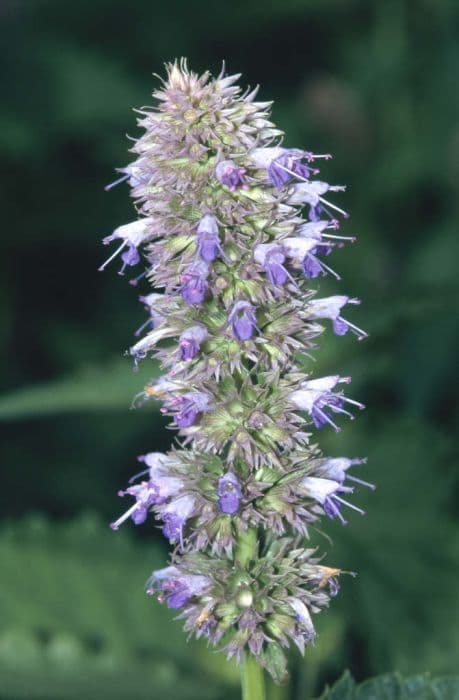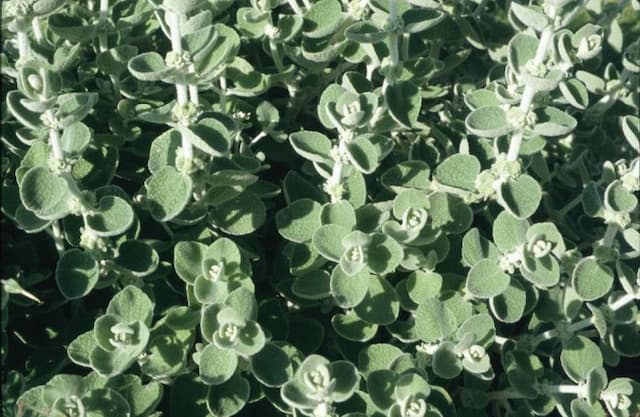Rosemary 'Lady in White' Salvia rosmarinus (Albiflora Group) 'Lady in White' (Ro)

ABOUT
'Lady in White' is a highly aromatic, compact, evergreen shrub to 60cm, with arching branches bearing dark green, needle-like leaves and small, white flowers in spring and autumn
About this plant
 Names
NamesSynonyms
White Rosemary, Lady in White Rosemary.
Common names
Rosmarinus officinalis 'Albus', Rosmarinus officinalis f. albiflorus, Rosmarinus officinalis 'Lady in White'
 Characteristics
CharacteristicsLife cycle
Perennials
Foliage type
Evergreen
Color of leaves
Green
Flower color
White
Height
2 feet (0.61 meters)
Spread
2 feet (0.61 meters)
Plant type
Shrub
Hardiness zones
8
Native area
Mediterranean
Benefits
 General Benefits
General Benefits- Culinary Use: Rosemary is a popular herb in cooking, adding a distinctive flavor to a variety of dishes including meats, soups, and sauces.
- Aromatic Qualities: 'Lady in White' emits a pleasant, pine-like fragrance that can be enjoyed in gardens or when used in potpourris.
- Attracts Pollinators: Its flowers can attract bees and other beneficial insects, supporting local ecosystems and pollination of nearby plants.
- Landscape Design: With its bushy habit and attractive white flowers, it is an excellent choice for garden borders, ornamental gardens, or as a hedge.
- Drought Tolerance: Once established, rosemary is quite drought-resistant, making it suitable for xeriscaping and water-wise gardens.
- Low Maintenance: It is easy to grow and requires minimal care, making it suitable for novice gardeners or those with limited time.
- Evergreen Foliage: Providing year-round greenery and structure to the garden as it retains its leaves throughout the seasons.
- Cold Resistance: 'Lady in White' can tolerate cold temperatures and is hardy in many climates, extending its growing range.
 Medical Properties
Medical Properties- Antioxidant: Rosemary contains compounds like rosmarinic acid and carnosic acid, known for their antioxidant properties that can help protect the body's cells from damage by free radicals.
- Anti-inflammatory: With ingredients such as the aforementioned rosmarinic acid, rosemary may help to reduce inflammation within the body.
- Antimicrobial: Rosemary oil has been found to have antimicrobial properties, which can be beneficial in fighting certain bacteria, fungi, and viruses.
- Cognitive enhancement: Some studies suggest that rosemary can improve concentration and memory, potentially due to its aroma acting upon the central nervous system.
- Digestion aid: Traditionally, rosemary has been used to help relieve digestive issues, such as heartburn, gas, and indigestion.
- Stress relief: The aroma of rosemary essential oil may have anxiolytic (anti-anxiety) effects and could be used to reduce stress and improve mood.
 Air-purifying Qualities
Air-purifying QualitiesThis plant is not specifically known for air purifying qualities.
 Other Uses
Other Uses- Rosemary can be used in the construction of flower arrangements to add a pleasant fragrance and a touch of greenery.
- Fabric Freshener: The leaves can be sewn into sachets and tucked into drawers or closets to impart a fresh scent to linens and clothing.
- Moth Repellent: Dried rosemary can be used as a natural repellent against moths in wardrobes and pantries.
- Freshen Up Carpets: Dried rosemary, along with other herbs, can be sprinkled over carpets before vacuuming to deodorize them.
- Insect Repellent: Rosemary's aromatic oils can help to deter certain insects and can be placed near windows or doors as a deterrent.
- Homemade Cosmetics: Essential oil derived from the plant can be used in homemade soaps, shampoos, or lotions.
- Culinary Decoration: The flowers and leaves can be used as an edible decoration on dishes, particularly on desserts or in cocktails.
- Artisanal Crafts: Dried sprigs of rosemary can be used to create natural wreaths or other decorative items.
- Flavor Smoking: Rosemary sprigs can be thrown onto the coals when barbecuing to infuse meat with a distinctive flavor.
- Homemade Cleaners: Rosemary can be infused into vinegar to make an all-natural, fragrant household cleaner.
Interesting Facts
 Feng Shui
Feng ShuiRosemary is often used in Feng Shui to purify and cleanse the energy of a space, promote clarity and concentration, and enhance memory. It is associated with the Fire element and can be placed in areas where you want to invite warmth or increase passion and enthusiasm in your life, such as the living room or office.
 Zodiac Sign Compitability
Zodiac Sign CompitabilityRosemary is not used in astrology practice.
 Plant Symbolism
Plant Symbolism- Memory: Rosemary is traditionally associated with remembrance and has been used in ceremonies such as weddings and funerals to symbolize the memory of loved ones and important occasions.
- Fidelity: Often used in wedding rituals, rosemary can symbolize fidelity between partners, representing a pledge of loyalty and commitment.
- Protection: Historically, rosemary has been believed to offer protection against evil spirits and negativity. It was commonly used to ward off harmful influences.
- Healing: Due to its various medicinal properties, rosemary is often associated with healing. It has been used in traditional medicine to treat various ailments.
- Purification: Rosemary's strong fragrance has been linked with cleansing and purifying both physical spaces and the mind, potentially enhancing mental clarity and cleansing negative energy.
- Love: Rosemary can symbolize love and is sometimes used to attract it or to strengthen a romantic bond between individuals.
 Water
WaterThe 'Lady in White' Rosemary prefers soil that is evenly moist but not waterlogged. Water this plant deeply once every 1 to 2 weeks, allowing the soil to dry out slightly between waterings. During hot, dry periods, you may need to water more frequently, especially if your Rosemary is in a container. Generally, provide 1 to 2 gallons of water per plant, per watering session, adjusting as necessary for your climate and the plant's needs.
 Light
LightRosemary 'Lady in White' thrives in full sun conditions and should be placed in a spot where it can receive at least 6 to 8 hours of direct sunlight daily. Avoid areas that are too shaded, as this can affect the plant's growth and flavor.
 Temperature
TemperatureRosemary 'Lady in White' does best in a temperate climate with temperatures ranging between 40 to 80 degrees Fahrenheit. It can survive dips down to 30 degrees Fahrenheit but should be protected or brought indoors if temperatures approach freezing, as it is not tolerant of extreme cold.
 Pruning
PruningPruning 'Lady in White' Rosemary is essential to maintain plant health and encourage bushier growth. Prune lightly in early spring to shape the plant and remove any dead or faded stems. Additional light trimming can be done throughout the growing season to maintain the desired shape.
 Cleaning
CleaningAs needed
 Soil
SoilRosemary 'Lady in White' prefers a well-draining soil mix with a pH between 6.0 to 7.5. A good soil recipe would be one part coarse sand, one part compost, and one part perlite or pumice to ensure proper drainage and aeration. Amend soil with lime if too acidic.
 Repotting
RepottingRosemary 'Lady in White' should be repotted every 1 to 2 years, ideally in spring. Repot only when the plant has outgrown its current container or the soil has degraded, ensuring minimal root disturbance.
 Humidity & Misting
Humidity & MistingRosemary 'Lady in White' thrives best in moderate humidity conditions, typically around 40-50%. It tolerates drier air but appreciates occasional misting if indoor air is particularly dry.
 Suitable locations
Suitable locationsIndoor
Place in bright spot, water when soil dries.
Outdoor
Sun exposure, well-draining soil, protect from frost.
Hardiness zone
7-10 USDA
 Life cycle
Life cycleSalvia rosmarinus 'Lady in White', commonly known as Rosemary, begins its life with seed germination in warm, well-drained soil conditions, often requiring stratification to break seed dormancy. Seedlings emerge and develop into young plants with needle-like leaves and a distinctive fragrance, requiring full sun exposure and minimal water once established. Vegetative growth progresses, with the plant developing woody stems and a bushy habit, continually producing leaves that can be harvested for culinary and aromatic uses. The plant reaches maturity and enters the reproductive phase, blooming with small white flowers typically in spring or summer, attracting pollinators such as bees. After pollination, seeds are produced and dispersed, initiating the potential start of a new generation. Rosemary is a perennial herb, capable of surviving for many years with proper care, going dormant in colder climates during winter months before resuming growth in the spring.
 Propogation
PropogationPropogation time
Spring-Early Summer
The most popular method of propagating Salvia rosmarinus 'Lady in White', commonly known as rosemary, is through stem cuttings. Ideally, cuttings should be taken in late spring or early summer to maximize their chance of rooting. To propagate, select a healthy, non-flowering shoot and cut a 2 to 4-inch (5 to 10 cm) piece from the parent plant. Strip the leaves from the bottom two-thirds of the cutting and dip the cut end into rooting hormone powder to encourage root growth. Then, insert the cutting into a pot filled with a mix of peat and perlite or a well-draining soil. Keep the cutting moist and in a warm, indirect light. Rooting typically occurs in about 6 to 8 weeks, after which the new rosemary plants can be transplanted to their permanent location.









